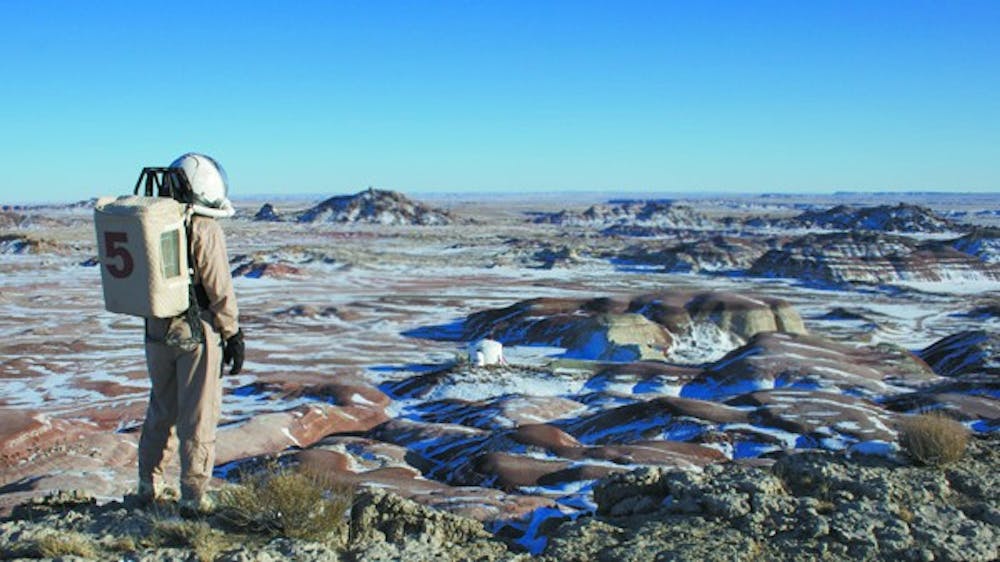In 1969, man walked on the moon for the first time. Now, ASU earth and space exploration junior Jim Crowell hopes to help humans set foot on Mars.
Crowell, 21, spent three weeks of his winter break at the Mars Desert Research Station in Utah as a crewmember of a simulated mission to Mars.
“We are explorers,” Crowell said. “It’s our nature. We're meant to go beyond the places we call home.”
The simulation was conducted by the Mars Society, a nonprofit organization with a purpose to explore and eventually settle the Red Planet. To help people learn what living and working on Mars would be like, the organization created the Mars Desert Research station as a testing ground.
For the last week of December, Crowell was part of an engineering refit crew that repaired simulation equipment. For the first half of January, he joined five students for the simulation.
The six crewmembers lived in a habitat — called the “Hab” for short — in the middle of the Mars-like, red-soiled desert of Utah, miles away from signs of human life. To leave the Hab, crewmembers had to put on a space suit and go through a de-pressurization sequence in a simulated airlock room, as if they were really on Mars, Crowell said.
“If you didn’t pressurize on Mars, the door would rip off and everyone would die,” Crowell said.
During the simulation, the crewmembers lived in close quarters with restrictive conditions. They ate dehydrated food, slept in 4-by-11 foot rooms in sleeping bags on air mattresses, and pumped water from tanks, Crowell said.
By day, the crew researched and participated in extravehicular activities. By night, they submitted reports to mission support and attempted to relax and enjoy some time alone.
Each crewmember worked on his or her own research project during the simulation. Crowell’s self-designed project was to take panoramic photographs of certain locations around the Hab and, with the help of GPS, compare them to corresponding satellite images.
It’s hard to discern details of foreign landscapes from satellite images, Crowell said, so he was using the knowledge of how certain geological features on Earth look from satellite to better map the landscapes of other planets or moons. Researchers need detailed topographical maps of the moon and Mars to decide on future landing sites, Crowell said, adding that he is focusing his research on the moon because of his involvement with the Lunar Reconnaissance Orbiter Camera at ASU.
According to NASA, the Lunar Reconnaissance Orbiter Camera (LROC) is a camera orbiting the moon that transmits images and data about the moon to researchers on Earth so they can decide on future landing sites and safely continue both robotic and human lunar exploration.
Crowell said he was using his Mars simulation research project to better assess the LROC images of the moon.
Ultimately, Crowell said his goal is to become an astronaut and help future space travel. He said he wants to help “normalize space” for everyone.
“Space isn’t just for the engineers or the scientists — it’s for everybody,” Crowell said.
To foster interest and knowledge of space for all people, Crowell helped start the ASU chapter of Students for the Exploration and Development of Space. Getting everybody interested in space is important because the need for space-related jobs will explode in the next few years with an increase in space tourism, he said.
“By the time our kids are our age, [traveling to space] is going to be normal,” Crowell said. “Science fiction won't be science fiction anymore.”
Steve Ruff, a faculty research associate at the ASU Mars Space Flight Facility, said commercial space tourism is likely to develop soon, starting with suborbital flights that allow passengers to experience a few minutes of zero gravity and fantastic views of Earth.
Well-to-do tourists will be the pioneers for space tourism, Ruff said. If everything runs smoothly for people who can afford the currently high cost of a space flight — for example, the company Virgin Galactic charges $200,000 for a ticket to space — then commercial space tourism companies will develop more affordable options, he said.
“If people are dying on these pleasure cruises, the markets are going to dry up,” Ruff said.
Tourism to the moon is plausible for the near future, but it’ll be a long time before even trained astronauts reach Mars, Ruff said. The next step in Mars exploration will be returning samples from Mars, he said.
Scientists need samples from Mars to make sure the planet doesn’t host hazardous microbes or materials that would threaten human life, Ruff said. Also, scientists have never returned any robotics from Mars, so they need to prove a return trip is possible before sending humans there, he said.
Ruff is involved in a committee called Mars Sample Return that is developing a three-phase strategy to bring Martian rock and dust samples to Earth. A two-pound, grapefruit-sized sample would cost more than $10 billion to return to Earth, Ruff said
Humans are technologically able to go to Mars themselves, but because of the high costs and potential hazards, Ruff said it’s not likely to happen for at least 100 years.
“There’s a romantic idea that we’ll colonize Mars,” Ruff said. “It’ll probably happen in the distant future.”
Steph Kost, a biological sciences sophomore, said she would go to space if the trip were reasonably priced, but she can’t picture a Mars colony developing any time soon.
“I love the idea of it — it’s so ‘Star Wars,’” Kost said. “But to actually set up a place for people to live seems like a lot of work for not a lot of benefit.”
Crowell, on the other hand, said he thinks people traveling to Mars is going to happen eventually.
“I don’t think humans are going to stay on Earth,” he said. “I want to be the one to make it happen.”
Reach the reporter at kkfrost@asu.edu





